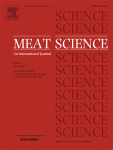Ver ítem
- xmlui.general.dspace_homeCentros e Institutos de InvestigaciónCIA. Centro de Investigaciones de AgroindustriaInstituto de Tecnología de AlimentosArtículos científicosxmlui.ArtifactBrowser.ItemViewer.trail
- Inicio
- Centros e Institutos de Investigación
- CIA. Centro de Investigaciones de Agroindustria
- Instituto de Tecnología de Alimentos
- Artículos científicos
- Ver ítem
Conjugated linoleic acid (CLA) and polyunsaturated fatty acids in muscle lipids of lambs from the Patagonian area of Argentina
Resumen
The concentrations of fatty acids were measured in total lipids, triacyglycerol and phospholipid fractions of intramuscular fat (IMF) from the Longissimus dorsi (LD) muscle of 10 lambs reared to approximately 30 kg live weight on natural pasture with their dams. Fatty acid composition was also measured in 25 (five of each) Semitendinosus (ST), Semimembranosus (SM), Rectus femoris (RF), Gluteus (GLU) and Tensor fascia latea (TFL) muscles. Intramuscular fat
[ver mas...]
The concentrations of fatty acids were measured in total lipids, triacyglycerol and phospholipid fractions of intramuscular fat (IMF) from the Longissimus dorsi (LD) muscle of 10 lambs reared to approximately 30 kg live weight on natural pasture with their dams. Fatty acid composition was also measured in 25 (five of each) Semitendinosus (ST), Semimembranosus (SM), Rectus femoris (RF), Gluteus (GLU) and Tensor fascia latea (TFL) muscles. Intramuscular fat percentages were similar for all muscles. Aspects of the fatty-acid patterns of relevance to human nutrition tended to favor the leg muscles with lower saturated fatty acids (SFA %), n−6/n−3 fatty acid ratios (p < 0.01) and higher concentrations of the conjugated linoleic acid (CLA) (p < 0.05). The estimated fatty acid concentrations (mg/100 g of meat) showed higher contribution of arachidonic (C20:4 n−6), eicosapentanoic (C20:5 n−3), docosapentanoic (C22:5 n−3) and docosahexanoic (C22:6 n−3) acids in leg compared to LD lipids.
[Cerrar]

Fuente
Meat Science 79 (3) : 541-548 (July 2008)
Fecha
2007-12-23
Editorial
Elsevier
ISSN
0309-1740
Formato
pdf
Tipo de documento
artículo
Palabras Claves
Derechos de acceso
Restringido
 Excepto donde se diga explicitamente, este item se publica bajo la siguiente descripción: Creative Commons Attribution-NonCommercial-ShareAlike 2.5 Unported (CC BY-NC-SA 2.5)
Excepto donde se diga explicitamente, este item se publica bajo la siguiente descripción: Creative Commons Attribution-NonCommercial-ShareAlike 2.5 Unported (CC BY-NC-SA 2.5)

